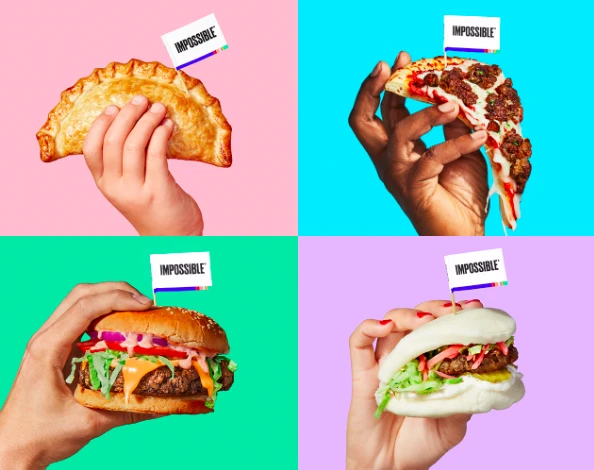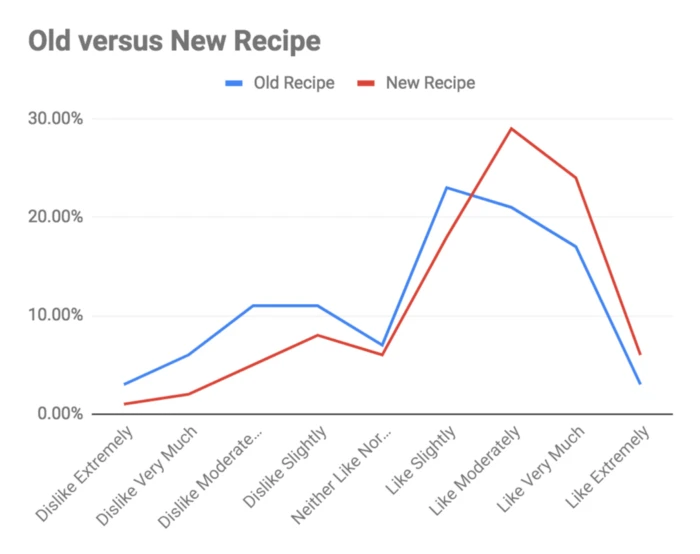Plant-Based Burger Confidence: How We Know You’ll Like ImpossibleTM Burger “Very Much”
By Dr. David Lipman, Chief Science Officer at Impossible Foods.

We launched the original Impossible Burger in 2016. But we didn’t stop there — the next day we started making it better. Today we launched recipe 2.0 of the Impossible Burger, one that’s better in every way. This is the story of how and why we did it.
My dad was meticulous about how the ground beef was prepared at his meat market back in Rochester, N.Y. From the cuts of meat we selected, to how we trimmed them, how fast we fed them into the grinder, and even to how we handled the meat itself as we weighed it out for the customers — we took exceptional care to deliver the very best beef to our loyal customers.
Today, I work with a team of over 100 scientists, engineers and researchers, and my job hasn’t changed much. We work together every day to make the best meat (and dairy and fish) the world has ever tasted — directly from plants. Over the past seven years, we’ve reached many fundamental milestones, including discovering what makes meat taste like meat(opens in a new tab) and the creation of our first product, the Impossible Burger. To get there, we spent years analyzing meat and recreating every element of the sensory experience — smell, flavor, texture, touch, nutrition, sizzle factor.
We’ve studied thousands of proteins and tested many hundreds of ingredients to get to our early prototypes, the first of over 20 before we landed on our first recipe. Most importantly, we conducted over 250 external consumer tests at four sites, involving more than 26,000 individual tastings — in the past four years alone.
Sensory testing is crucial.
Great meat flavor doesn’t come easily: human flavor perception isn’t as simple as it may seem. As neurobiologist Gordon Shepherd writes,
The multiple neural mechanisms involved in producing flavor include sensory, motor, cognitive, emotional, language, pre- and post-ingestive, hormonal, and metabolic. It can be claimed that more brain systems are engaged in producing flavor perceptions than in any other human behavior.
Owing to the complexity of flavor perception, we’ve incorporated specific methods and facilities for its scientific study.
One of these is paired preference testing. In these tests, consumers evaluate pairs of different products “blindly” (they’re told nothing about the brand, concept or ingredients) and are asked to indicate their preferences.
Some sensory testing is relatively straightforward. Suppose we change our recipe to reduce saturated fat content by replacing coconut oil with a blend of coconut and sunflower oils. To test this change, we’ll ask tasters to sort a mixture of unlabeled food samples into two groups, and assess whether they can successfully put each formulation into its own group. If most consumers can’t sort them correctly — ie, can’t distinguish the new recipe from the old — then we know we can make the change.
In these tests, burgers are typically served as unadorned patties (“naked”) or, less often, on a bun with all the fixings (“fully dressed”) depending on the test objective. Taste tests with “naked” patties allow us to discern the finer differences between the patties without being skewed by condiments, whereas tests with “fully dressed” burgers show us which differences are likely to matter “in the wild.” We also ask consumers to describe, in their own words, what they like and dislike about the burgers — on flavor, appearance, texture and overall sensory experience — which helps provide further direction for improvements in our recipe.
More commonly, however, the changes we make are intended to be distinguishable, and we need to ensure that consumers will like the new recipe at least as much as the old one. To test this, we run blind paired preference testing at independent university research facilities across the country, where we ask 100–200 regularly meat-eating consumers which of the two burger recipes they prefer.
The paired preference approach is useful for deciding whether a particular recipe change is worth making, but it doesn’t help to answer an important question:
How Much Will You Actually Like the Impossible Burger When You Try It in the Real World?
The Nine-Point Hedonic Scale, a form of likability testing, was developed in the 1950s for this purpose. In addition to paired preference tests, we always ask tasters how much they liked each sample using this simple nine-point scale.

Naturally, there are some methodological issues with this likability scoring approach: e.g. the “contrast effect” (the higher the quality of burger recipe “A,” the lower the liking score for burger recipe “B”, and vice versa), differences in test site averages (consumers from different areas of the country may have different general behavioral preferences), and skewed test results based on inconsistent test sample preparation.
All this contextual variability and sensitivity sounds a lot like the real world — and it is. If we collect enough data from enough different sites in enough different testing contexts, we can get much closer to answering that question.
Why Did We Change Our Recipe? And More Importantly, will You Like It?
Today, we launched an all-around better recipe that rivals beef in the attributes that matter most: nutrition, versatility and, of course, taste.
We aimed to improve the nutritional profile and did exactly that, delivering a new product with fewer calories, lower total fat, lower saturated fat and lower sodium. We swapped the wheat protein for soy protein(opens in a new tab) — higher quality protein by PDCAAS (Protein Digestibility-Corrected Amino Acid Score)(opens in a new tab) standards — and reduced the amount of coconut oil while adding sunflower oil.

We optimized the original Impossible Burger for taste, yes, but also to be cooked on a flat-top in restaurants and served as a burger: what most restaurants wanted. For Impossible Burger 2.0, we wanted to deliver a product that could be used in any ground beef recipe — especially important as we enter home kitchens this year. We tested a few new ingredients and over 59 home recipes to confirm: the new Impossible Burger can be used in any cooking application — from the grill to the cast iron, braised, stewed, steamed or sautéed.
Most importantly, we wanted to make the Impossible Burger so delicious that people would look forward to eating the Impossible Burger again and again, share the experience with their friends and post rave reviews. To do this, we ran over 10,000 taste tests and tested over 90 different Impossible Burger recipes.

This graph includes data from over 1500 taste tests, and compares the distribution of likability scores of the original Impossible burger with those of the new recipe (both as “naked” burgers with no condiments).
The final result: In less than one year of intensive R&D, likability testing shows a dramatic drop in the number of people who didn’t like the Impossible Burger and a similar increase in the number who “Like It Very Much.”
Paired preference taste tests between the new and original recipes also indicate that the new was favored by more than twice as many consumers as the original.
And Ground Beef From Cows?
The cow has been around for millions of years, and it’s never been a great technology for making meat. Throughout our ongoing efforts to improve the Impossible Burger, we’ve learned a lot about how it compares to ground beef from cows in sensory tests. This year, we’re proud to say that we’ve dramatically reduced the gap. Not only does the Impossible Burger rival ground beef from cows in likability testing; it’s on track to beat it.
The beef you buy today at the supermarket today is certainly no better than what I sold fifty years ago at my father’s meat market — the cow isn’t getting any better at turning plants into meat. At Impossible Foods, we’ve been working on a way to turn plants into meat for only seven years, and we’re getting better at it every day.
Today, we’re on the verge of passing the cow and we’re not slowing down. Try our latest recipe(opens in a new tab), and let us know what you think! Meanwhile, we’ll be working on the next one.
Check out our website to find the new recipe near you(opens in a new tab). Questions? Reach out to [email protected]. We’d love to hear from you